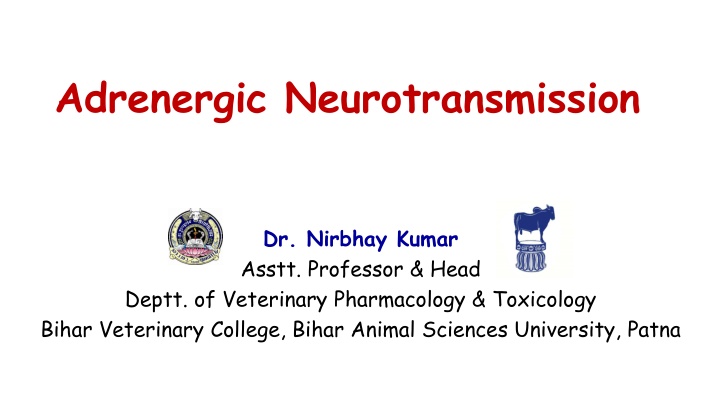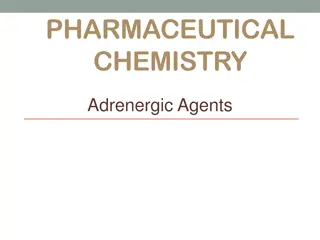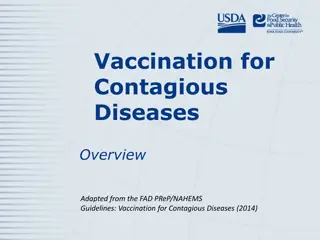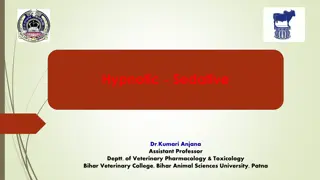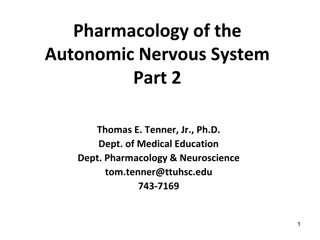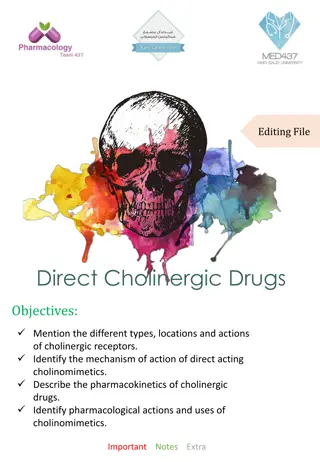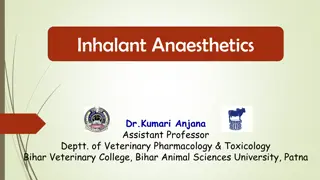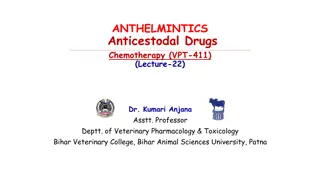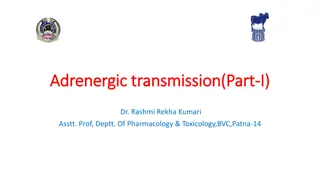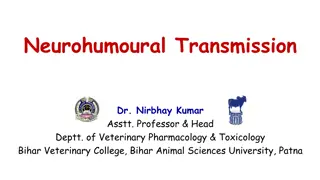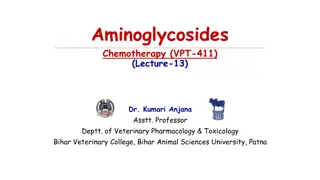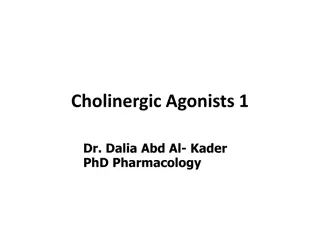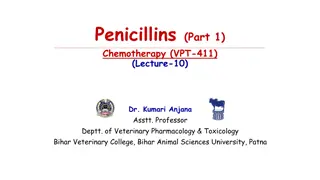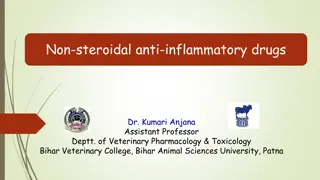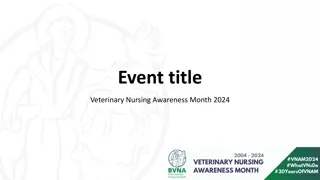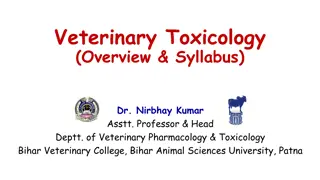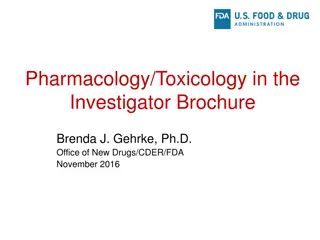Adrenergic Neurotransmission in Veterinary Pharmacology
Adrenergic neurotransmission, mediated by norepinephrine, dopamine, and epinephrine, plays a crucial role in various physiological processes. This process involves synthesis, storage, release, and termination of catecholamines like norepinephrine and epinephrine. The intricate mechanisms of neurotransmitter uptake and recycling are essential for regulating the action of catecholamines in the nervous system.
Download Presentation

Please find below an Image/Link to download the presentation.
The content on the website is provided AS IS for your information and personal use only. It may not be sold, licensed, or shared on other websites without obtaining consent from the author.If you encounter any issues during the download, it is possible that the publisher has removed the file from their server.
You are allowed to download the files provided on this website for personal or commercial use, subject to the condition that they are used lawfully. All files are the property of their respective owners.
The content on the website is provided AS IS for your information and personal use only. It may not be sold, licensed, or shared on other websites without obtaining consent from the author.
E N D
Presentation Transcript
Adrenergic Neurotransmission Dr. Nirbhay Kumar Asstt. Professor & Head Deptt. of Veterinary Pharmacology & Toxicology Bihar Veterinary College, Bihar Animal Sciences University, Patna
Adrenergic Transmission The impulse transmission that is mediated by norepinephrine (post-ganglionic sympathetic nerve terminals and CNS), dopamine (CNS) and epinephrine (adrenal medulla) is in general called as adrenergic transmission. All these transmitters are also called as catecholamines. CATECHOLAMINES: Norepinephrine: It acts as transmitter at most peripheral sympathetic neuroeffector junctions and in the CNS. It is the major hormone released from adrenal medulla. It is believed to transmit impulse information in specific areas within the CNS (basal ganglia, limbic system, CTZ, anterior pituitary etc.). Epinephrine : Dopamine :
Synthesis of Catecholamines Step I: Phenylalanine Tyrosine Step II: Tyrosine DOPA (Rate Limiting Step) Step III: DOPA Dopamine Step IV: Dopamine Norepinephrine Step V: Norepinephrine Epinephrine
Storage of Catecholamines Catecholamines are taken up from the cytoplasm into vesicles or granules by an active transport system which is ATP and Mg2+ dependent. Storage within the granular vesicles is accomplished by complexation of the catecholamines with ATP (in molecular ratio of 4:1) which is adsorbed on a protein, chromogranin. This complexation renders the amine inactive until their release. The intra-granular pool of NE is the principal source of neurotransmitter released upon nerve stimulation. The cytoplasmic pool of catecholamines is kept low by the enzyme monoamine oxidase (MAO) present in neuronal mitochondria. [NB:Reserpine is a drug which depletes catecholamine stores by inhibiting monoamine transport into vesicles].
Release & Termination of action of Catecholamines Release of Catecholamines: The nerve impulse coupled release of catecholamines from adrenergic nerve terminals takes place by exocytosis and is dependent upon an inward movement of Ca2+. Released norepinephrine migrates across the synaptic cleft and interacts with specific adrenergic receptor sites on the post-junctional membrane. Bretylium inhibits norepinephrine release. Termination of Catecholamines action: Uptake of Catecholamines: There is a very efficient mechanism by which norepinephrine released from the nerve terminal is recaptured. Exogenously administered norepinephrine and epinephrine are taken up into sympathetic nerve endings by this uptake process. Conservation of catecholamine neurotransmitters by reuptake is one of the first examples of recycling used products.
Uptake of Catecholamines Axonal uptake (Uptake - 1) (i) The adrenergic neuronal uptake is referred to as uptake-1. This uptake is the most important mechanism for terminating the action post-junctional action of NE. (ii) Uptake-1 is saturable and operates at very low concentrations of transmitter. (iii) Uptake-1 requires Na+ ions, K+ ions and ATP and is blocked by cocaine, desipramine & guanethidine antihistaminics. Extraneuronal uptake (Uptake -2) (i) It signifies the extraneuronal uptake of catecholamines into surrounding tissue. (ii) Uptake-2 has very large capacity and operates most effectively at high concentrations of NE. (iii) Uptake-2 is less selective, and is not blocked by cocaine but is sensitive to cortisol. It is not of pharmacological importance. accumulation physiological its congeners many and H1
Metabolism of Catecholamines The duration of action of catecholamines can be terminated either by reuptake mechanisms or metabolism by enzymes monoamine oxidase (MAO) and catechol o-methyl transferase (COMT). Cytoplasmic NE is attacked by MAO. The extraneuronal NE which diffuses into circulation is destroyed by COMT in liver and other tissues like kidney, brain etc. However, metabolism does not play an important role in terminating the action of endogenous catecholamines.
Adrenergic Receptors Adrenergic receptors have been classified into two types based on rank order of potencies of adrenergic agonists and receptors. Catecholamines produce excitatory (except GIT) and inhibitory (except CVS) responses on smooth muscles upon activation of and receptors, respectively. receptors have been further classified into two subtypes 1 and 2. Molecular cloning have further identified three subtypes of 1 ( 1A, 1B & 1D) and three subtypes of 2 ( 2A, 2B & 2C) receptors. receptors can be classified in three subtypes 1, 2 and 3 based on relative organ specificity of selective agonists and antagonists.
Characteristics of sub-types of Adrenergic Receptors Receptor Agonist Antagonist Tissue distribution & Responses Vascular smooth muscle: Contraction Genitourinary smooth m.: Contraction Liver: Glycogenolysis, gluconeogenesis Intestinal smooth m.: Relaxation* Heart: Increased contractile force Pancreatic islets: insulin secretion Platelets: Aggregation Nerve terminals: Decreased release of NE Vascular smooth muscle: Contraction Heart: force & rate of contraction & AV nodal conduction velocity. Juxtaglomerular cells: renin secretion Smooth muscles: Relaxation [vascular, bronchial, GI & genitourinary] Skeletal muscles: Glycogenolysis. Liver: Glycogenolysis, gluconeogenesis. Adipose tissue: Lipolysis. Epi NE Iso Phenylephrine 1 Prazosin Epi NE Iso Clonidine 2 Yohimbine Iso> Epi=NE Dobutamine Metoprolol Atenolol 1 Iso>Epi>>NE Terbutaline Salbutamol a-methyl propranolol 2 3 Iso=NE>Epi -
Points to remember EPI NE >> isoproterenol for adrenergic receptors. Isoproterenol > EPI NE for adrenergic receptors. Importat: Epinephrine: 1 + 2 + 1 + 2 and weak 3 action. Norepinephrine: 1 + 2 + 1 + 3 but no 2 action. Isoproterenol: 1 + 2 + 3 but no action.
